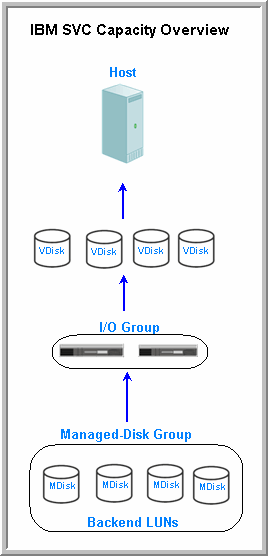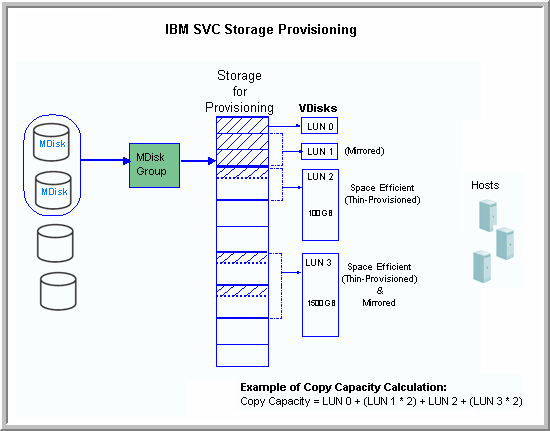IBM SAN Volume Controller Overview
The IBM SAN Volume Controller (SVC) provides virtualized storage—that is, an array of arrays. As such, this technology requires specific terminology to describe physical and logical configurations. Since APTARE StorageConsole reports on a variety of storage systems, the following table offers a simple glossary of terminology in the context of heterogeneous storage reporting.
Generic Terminology | Corresponding SVC-specific Terminology |
Array | Cluster (up to 4 pairs of nodes) |
Disk, Hard Disk, or Raw Storage | MDisk (managed disk) or Backend LUN, which is the physical storage carved up into logical units |
Storage Pool | MDisk Group |
LUN | VDisk (virtual disk); often referred to as front-end storage |
Node | One SAN Volume Controller |
Figure 3.2 Overview of IBM SVC Architecture
The following diagram illustrates the elements comprising the storage provisioning process, from back-end MDisks to creating RAID disks for VDisk LUNs. The storage in VDisk LUNs is the capacity that is presented to Hosts.
Use this diagram to understand how certain values are displayed in the StorageConsole SVC reports:
• Copy Capacity includes both mirrored and un-mirrored LUNs.
• Space-Efficient VDisks (LUNs), also known as thin-provisioned storage, can have VDisk LUN capacity that is greater than the Allocated Disk capacity (displayed as Real Capacity in some reports).
Figure 3.3 Example of IBM SVC Storage Provisioning
Space-efficient VDisks
A Virtual Disk (VDisk) can be configured as space-efficient, which means that it has both virtual and real capacity.
• Virtual Capacity - VDisk storage that is available to hosts
• Real Capacity - Physical storage from an MDisk that is allocated to a VDisk copy
For a fully allocated VDisk (all real capacity), virtual and real capacity are identical; however, in a space-efficient VDisk, virtual capacity can exceed real capacity.


